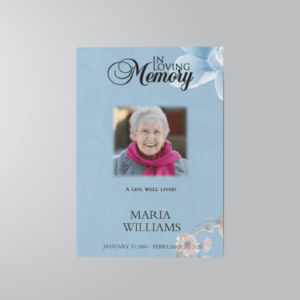Funerals are solemn occasions that require thoughtful planning, including the creation of pamphlets that honor and commemorate the life of the departed. Pamphlets, also known as funeral programs or memorial folders, are printed documents that serve as a guide for attendees, providing information about the order of service, the deceased’s life story, and other relevant details.
Why Are Pamphlets Important for Funerals?
Pamphlets play a crucial role in funerals for several reasons. Firstly, they serve as a keepsake for attendees, providing them with a tangible reminder of the person they are there to honor. Pamphlets often include photos, quotes, and personal messages that help capture the essence of the deceased’s life and personality.
Secondly, pamphlets help to organize the funeral service, providing a timeline of events and guiding attendees through the proceedings. They can also include hymns, prayers, and readings that are meaningful to the deceased and their loved ones, helping to create a personalized and meaningful service.
Finally, pamphlets can serve as a way to inform attendees about the deceased’s life and legacy. They can include biographical information, details about their achievements and contributions, and messages from family and friends, providing a comprehensive overview of the person’s life and impact.
Key Components of Pamphlets for Funerals
While the specific content of pamphlets can vary based on personal preferences and cultural traditions, several key components are commonly included:
Cover Design
The cover of the pamphlet often includes a photo of the deceased, their name, and the dates of their birth and death. It may also include a meaningful quote or image.
Order of Service
The funeral pamphlet includes a detailed outline of the funeral service, including the sequence of events, hymns, prayers, and readings.
Biographical Information
A section of the pamphlet is often dedicated to providing information about the deceased, including their life story, achievements, and contributions.
Photos
Photos of the deceased are commonly included throughout the pamphlet, helping to personalize the document and provide visual memories for attendees.
Messages from Family and Friends
Pamphlets often include messages from family members, friends, and colleagues, sharing memories and reflections on the deceased’s life.
Poems, Readings, and Prayers
Poems, readings, and prayers that are meaningful to the deceased and their loved ones are often included in the pamphlet.
Funeral Home Information
Contact information for the funeral home or crematorium may be included, as well as details about burial or cremation arrangements.
How to Create a Meaningful Pamphlet for a Funeral
Creating a meaningful pamphlet for a funeral involves thoughtful planning and attention to detail. Here are some steps to help you create a pamphlet that honors your loved one’s life and legacy:
Gather Information: Start by gathering biographical information, photos, and messages from family and friends. This will form the basis of the content for your pamphlet.
Design the Layout: Consider the layout and design of your pamphlet, including the cover design, font styles, and colors. Choose a design that reflects the personality and style of the deceased.
Write the Content: Write the content for your pamphlet, including the order of service, biographical information, and messages from family and friends. Ensure that the content is clear, concise, and meaningful.
Include Personal Touches: Add personal touches to your pamphlet, such as favorite quotes, poems, or songs of the deceased. This will help to make the pamphlet more meaningful and personalized.
Review and Edit: Review the content of your pamphlet carefully, checking for any errors or omissions. Consider asking a friend or family member to review it as well.
Print and Distribute: Once you are satisfied with the content and design of your pamphlet, print copies for distribution at the funeral service. Consider printing extra copies for attendees to take home as keepsakes.
Collect Feedback: After the funeral service, collect feedback from attendees about the pamphlet. This will help you to understand what aspects were most meaningful and memorable to them.























































